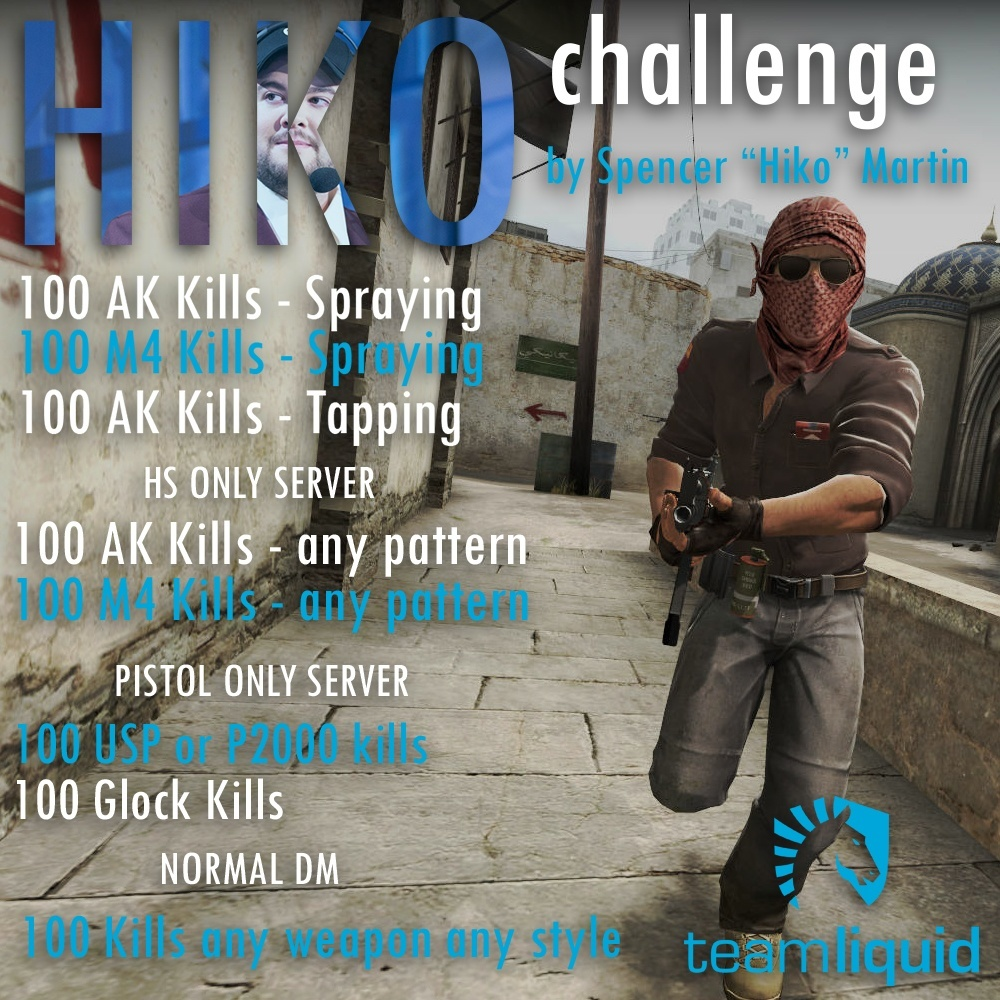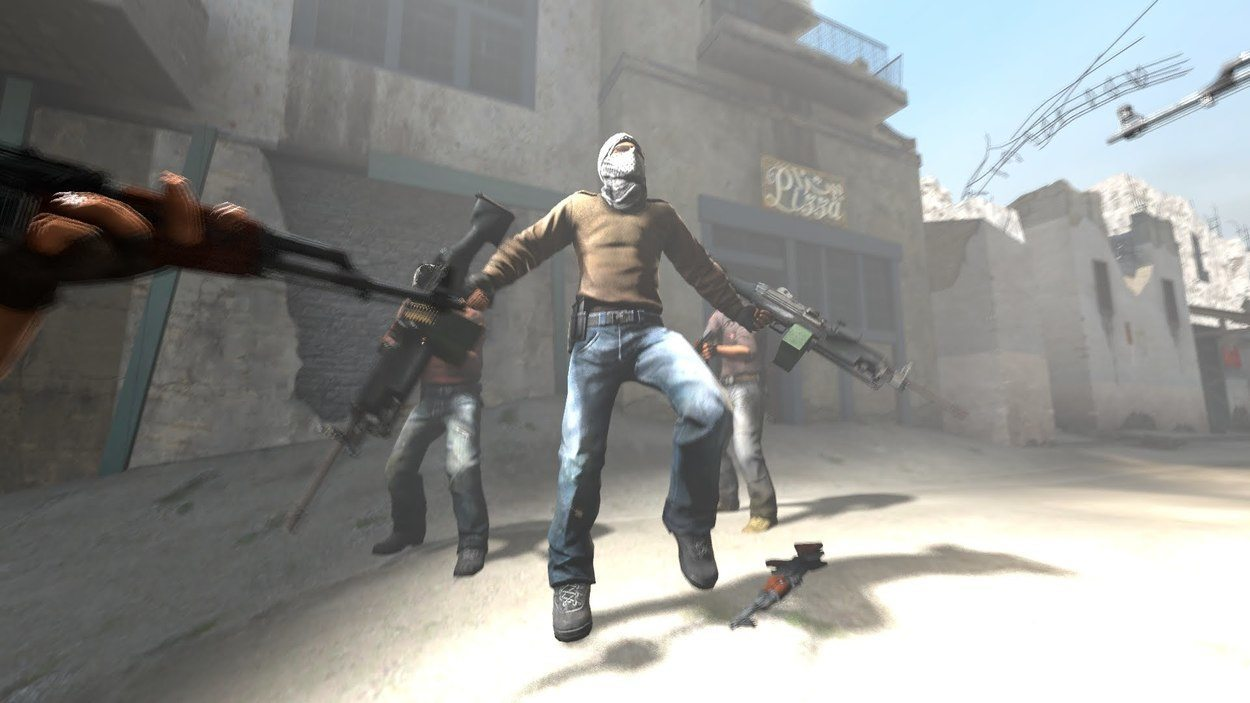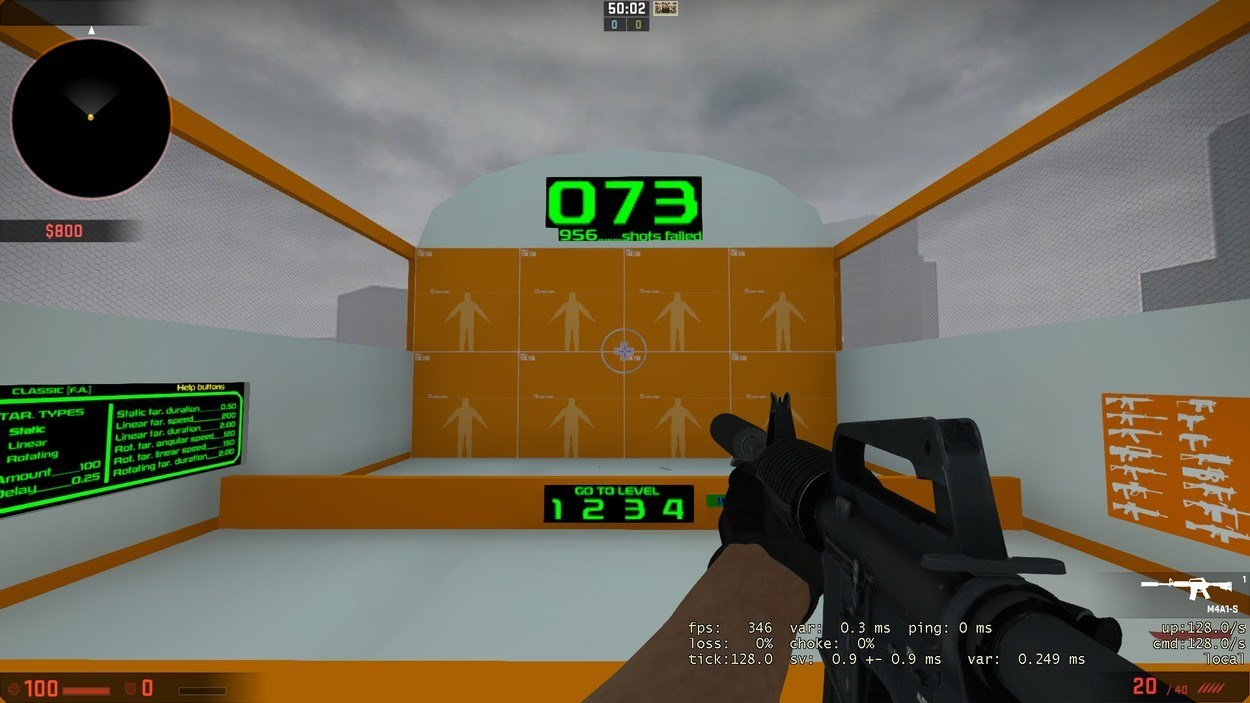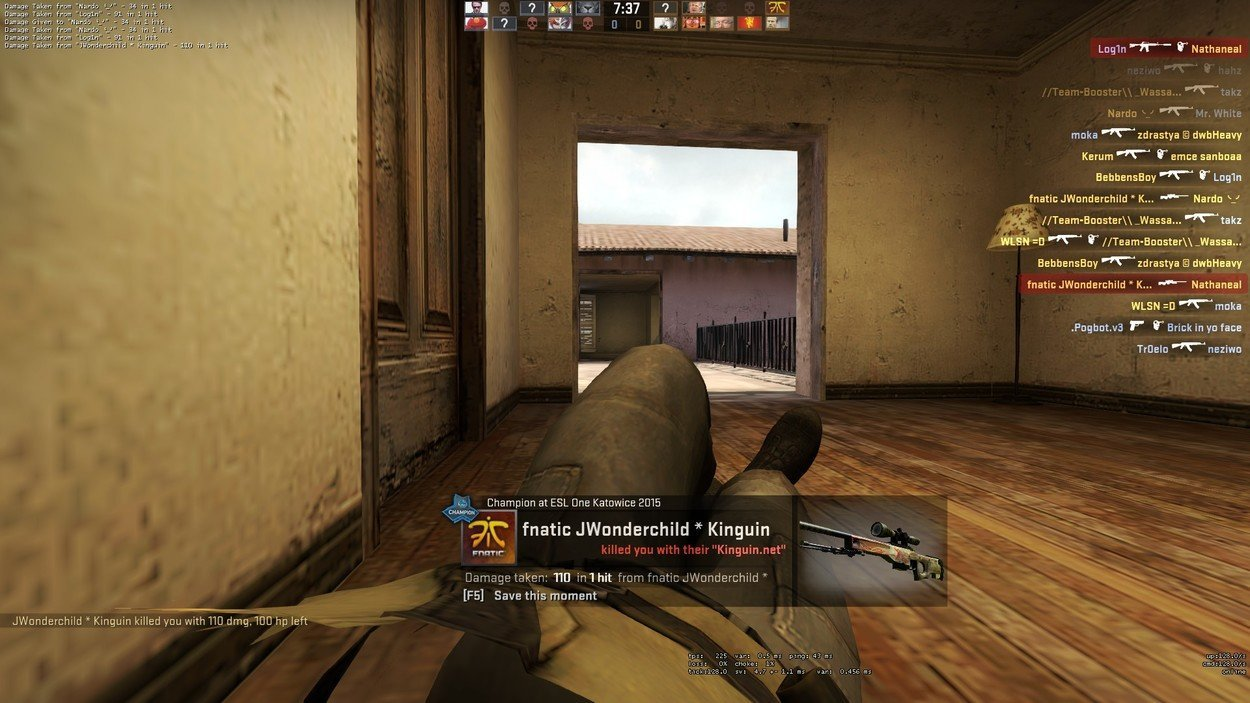Training Programs in CSGO: Become Better - Efficiently!
Have you ever wanted to become a better CS:GO player? Here is the guide to get your training started!
Have you ever wanted to become a better CS:GO player? Here is the guide to get your training started!
As I was browsing reddit the other day, I noticed a quite interesting thread about the so called “Hiko Challenge”. The challenge was tweeted by Spencer ‘Hiko’ Martin of Team Liquid and consists of a routine featuring 800 kills on different deathmatch server mods with the main weapons and pistols. The popular streamer asked his followers to complete the challenge and tweet their best times to him, as he was able to rack up the needed kill count in less than 90 minutes.

Courtesy of /u/officialrexoN
While this challenge is probably not meant as a proper training program, we all see posts like these creep up on social media from time to time. Young professionals sharing their way to improve aim, established pros giving tips on how to practice. All of these are very useful pieces of information but those routines are mostly developed over several years and probably work best for the individual sharing them. Not everyone needs to work on exactly the same skills which are outlined in the given program.
Now, it took me more than 2 hours to complete the challenge. Of course I still do have terrible aim but the about 20 minutes of waiting to get into servers did not help either. If you have a standard everyday nine-to-five job, maybe a partner, family, or pet iguana to take care of, dedicating 90 minutes to 2 hours of your valuable free time to aim training is probably not feasible for you.
You probably don’t even have any aspiration to bring your shooting skills to an inhuman level. You might just play CS for fun. But having fun in Counter-Strike usually involves winning and training the needed skills to do so more often than not has an impact on win-rate. This is where programming comes in.
What’s programming?
Programming is a term coined by sports trainers (especially in the fitness and strength sports) which roughly incorporates all processes that go into building a good training plan for a certain athlete. Not to dig too deep into the “is eSports real sport” debate here, but if one strives to become good at a game or sport, why not adopt measures other sports have been using for decades?
The procedure of programming therefore hinges on a multitude of factors: On the one side on the athlete with his or her specification and distinct goals. A powerlifter will train differently than a bodybuilder, an AWP player will focus on a bit different skills than a rifle player and a professional requires a different frequency and intensity than an amateur.
On the other side, this does not mean that different individuals cannot profit from a similar training style. If you only train how to aim but never learned a single popflash, you’ll most likely never be as good a players as you could be in the same way that never doing mobility work hinders a strength athlete to become stronger.
Which parts should go into a good training program?
First and foremost: You. Your brain and your dedication. No one knows where the weak spots are better than yourself and the best possible routine will not make you a better player if you just don’t do it. So analyze how much time per week or per day you are willing to dedicate to your training and plan it accordingly.
The second thing to keep in mind before assembling all the building blocks that go into a training routine is what aspects actually constitute your skill in Counter Strike. Certainly this list can never be complete but a few things instantly come to mind in this context: aim, grenade work, movement and gamesense are only a few.
While each of these skills is a complex construct in itself, a detailed look at all of them would bust the frame of this guide so let’s take an exemplary look at the biggest one of them for them – aiming. “Aim”, as in your ability to shoot the guns in the game, roughly consists of tracking, flicking, recoil control and crosshair placement as major components.

Image courtesy of saintblue52
If you have a few hundred games of CS played, you probably know fully well which of the mentioned aspects is lacking for you and which one works best. This might also correlate with the “role” you like to play as an entry fragger has a different emphasis in his play-style than an AWPer.
When you’re still in the dark about which parts of gameplay are especially in need of a polishing, going over the last two or three demos of yourself (and no – watching highlights does not count here) might give you a good idea.
Each of the described gameplay components can be trained in isolation on dedicated bot maps or as combined compound on e.g. deathmatch and retake servers. In the following I’ll go over the process of finding a suitable program with an example.
Sample Program
Let’s put the theory into practice to get an idea for how a training program might look like. As an example I’ll take myself because it’s time for a new routine anyway!
I’m a student without a pet iguana and really want to become better at CS. Thusly I’m willing to commit 2 hours, three times a week to my training. For the medium skill level I am currently around, my flicking is good, recoil control is okay, crosshair placement needs some work and my tracking is downright atrocious. Movement and peeking could be better, but after a few demo reviews I’d consider grenade work and gamesense as my strong points.
With the painful soul searching out of the way, we have the foundation to build the program upon:
Points 1 through 4 constitute the basis of my routine in which I try to work on my weak points. These will be completed every three days, while the rest can be substituted for practicing other aspects of the game.
When making your own program, you might either not have that much time or are eager to invest even more. It is important to keep in mind however, that each server switch could take multiple minutes depending on the time of day and the capacity of your favorite DM or retake servers. Therefore, segments that are less than 20 minutes long are not feasible in most cases. So if you only had one hour per training session, try to keep the intervals once on the servers as long as possible, reducing the total number of segments (e.g.: 10 min. Warmup / 20 min. Bot-Map / 30 min. general FFA DM).
Apart from warming up your aim first, there should not be any rules regarding the sequencing of what training is done. For me, personal preference is to move from exercise for single parts of my shooting abilities to more complex game modes like retake servers, with a relaxed segment of grenade work at the end. If you find yourself struggling to remember the trained grenades, maybe consider starting with the nade work segment. It’s all dependent on the individual player.
Reiterating the Process
I know a lot of you will already be familiar with the exercise maps I’m about to show, so at this point let’s quickly recap the process of programming for CS:GO in a snappy to-do list:
So this is it. Not exactly rocket-science but sometimes the simplest things can be the hardest to grasp. Having said this, I hope that this introduction to the concept of programming a training routine has given you some thought-provoking impulses on making or revising your own routine.
As always, your critique, thoughts or suggestions are warmly welcome. Send them to me here under the blog, on reddit at /u/TheMnR or in a private message. I’ll leave you now with a selection of possible ways to start your rocky training montage and may the matchmaking gods look kindly unto your matches.
Appendix: The Exercises
In the following a few select maps and game modes are presented as ways to train specific skillsets. This overview is only meant as a starting point. All of the presented methods have pros and cons depending on how and for what they are used.
- Bot and Training Maps
These maps are community made and can be downloaded from the steamcommunity workshop. They have the advantage that they can be played offline, whenever you want and without any stress involved. On the other hand they naturally can not emulate another player’s movement or the pressure that comes by competing with an opponent.
a. Aim_Botz
The bread and butter for most people’s aim training. Amazingly versatile, easy to use and still actively supported by its creator. Pretty much all aspects of aiming can be trained on this map (except for crosshair placement). If you haven’t tried it out yourself by now, definitely give it a shot.
uLLeticaL’s second map to be aptly named. Recoil Master pretty much took the practice of “spraying against a wall on dust2 until you got it” to a completely new level. Found a better way to get a feeling for the recoil of the guns? Let me know in the comments!

Around since source and well known as Adam ‘friberg’ Friberg’s way to warm up before important matches. While this map might not be as versatile as aim_botz it offers the option to quantify your skills.
It’s especially great for training flickshots.
d. Bot_Aim_v5d
A very simple map but one of my personal favorites. The bots spawn in front of you on different heights and the terrain can be altered to fit you r needs. Because of the comparably small spawning area racking up hundreds of kills is done in just a few minutes tapping, bursting or spraying to your heart’s content.
e. Grenade practice maps
If aim training is the equivalent of bicep curls, grenade work is cardio in that that everybody loves to talk about it but nobody actually ever does it. Whether you like to watch a youtube video on the most important smokes for a map and then practice them on an empty server or use one of the dedicated workshop maps does not really matter.
Either way, being the guy who does not know how to smoke a single spot in an A-take on mirage is not something to aspire.
- Community Servers
Training your aim against bots is well and good but not a complete substitute for measuring up against real opponents. Put those newly polished skills to work!
a. FFA DM
20 people on the server, everyone can shoot everybody and no spawn protection. If you are only used to Valve’s DM servers all of this can be quite a bit intimidating as the skill level and intensity here is substantially higher. On the flipside, this also makes the training quite a bit more effective – if you can find a place on a server. Don’t get caught up on k/d/a too much.
All aspects of aiming are challenged here as well as movement. Most of the time, these servers will be set to dust2, but a few rounds on other maps can do wonders for your crosshair placement there.

b. Aim map DM
Shunned by many but still frequently used by pros, Aim map DM servers still flourish. As your opponents will always spawn in front of you, the kill count goes up even faster than in FFA DM. Due to map layout, this game type mostly focusses on flicking, tapping and peeking.
c. 1v1 / Arena Servers
The name is self explanatory. Both contestants pick their weapon of choice and who wins gets to move up to the next arena, the looser drops down. This way you are likely to find a few equally skilled opponents on a crowded server.
This mode is ideal to train intense aim battle situations and also peeking.
d. Retake Servers
The Ts get to plant the bomb on a bombsite and the CTs spawn somewhere on the map and have to retake the site. Shocker right? You spawn with a random set of grenades and have to use them accordingly.
These servers train pretty much every gameplay aspect but tend to fall into certain pattern like Ts pushing through double doors on dust2 B. The skill level is usually well above average on these servers and you might meet one or the other pro if you’re (un-)lucky.
What about Surf and KZ?
Each time someone asks how to improve one’s movement, the unanimous answer is usually: KZ and surf!
Here I have to disagree. While KZ and surf certainly will give you a good feeling for the intricacies of tricky jumps and strafes, movement in a matchmaking context is mostly something completely different. Before teaching a player how to acquire launders style b-hops, it might be better to start with proper peeking and other micro level movements like a-d-a-d velocity cancels.
Since de_nuke’s ladder jump was removed, very few complicated movement tricks remain in the active duty map pool (e.g.: self boost onto quad on inferno) and those can be trained specifically if so desired.
Starting KZ or surf is a dangerous path, because it is so much fun. A fellow player once told me to start doing KZ to improve my movement. 350 hours spent in KZ later, I now am able to hit 278 unit long jumps. Has that helped my overall CS:GO skill? As pre-strafing is not enable on MM servers, probably not much.
Are you into fantasy leagues? Then check out AlphaDraft and put together your allstar lineup!